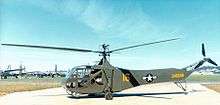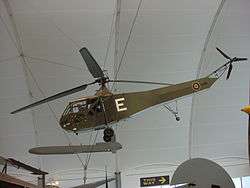Sikorsky R-4
| R-4 / Hoverfly | |
|---|---|
 | |
| Comdr. Frank A. Erickson, USCG & Dr. Igor Sikorsky, Sikorsky Helicopter HNS-1 C.G. 39040 | |
| Role | Helicopter |
| Manufacturer | Sikorsky Aircraft |
| Designer | Igor Sikorsky |
| First flight | 14 January 1942 |
| Primary users | United States Army Air Forces United States Coast Guard Royal Air Force |
| Produced | 1942–1944 |
| Number built | 131 |
| Developed from | Vought-Sikorsky VS-300 |
| Developed into | Sikorsky R-6 |

The Sikorsky R-4 was a two-seat helicopter designed by Igor Sikorsky with a single, three-bladed main rotor and powered by a radial engine. The R-4 was the world's first large-scale mass-produced helicopter and the first helicopter used by the United States Army Air Forces,[1] the United States Navy, the United States Coast Guard and the United Kingdom′s Royal Air Force and Royal Navy. In U.S. Navy and U.S. Coast Guard service, the helicopter was known as the Sikorsky HNS-1. In British service, it was known as the Hoverfly.
Development
The VS-316 was developed from the famous experimental VS-300 helicopter, invented by Igor Sikorsky and publicly demonstrated in 1940. The VS-316 was designated the XR-4, under the United States Army Air Forces' series for "Rotorcraft". The XR-4 first flew on 14 January 1942,[2][3] and was accepted by the Army on 30 May 1942. The XR-4 exceeded all the previous helicopter endurance, altitude and airspeed records that had been set before it. The XR-4 completed a 761-mile (1,225 km) cross-country flight from Connecticut to Wright Field, Ohio, set a service ceiling record of 12,000 feet (3,700 m), while achieving 100 flight hours without a major incident and an airspeed approaching 90 mph (140 km/h).[4]
The British Admiralty, having learned of the VS-300, made a ship available that had been intended to show the USN their work with autogyros and ship operations. The Empire Mersey was fitted with an 80 ft × 40 ft (24 m × 12 m) landing platform.[5] After her loss in 1942 to a U-boat, she was replaced by the SS Daghestan.[6] The first deck landing trials on Daghestan were carried out in 1944[5] The British received two of the first eight helicopters built.
On 5 January 1943, the United States Army Air Forces ordered 29 prototypes.[4] The first three prototypes were designated as the YR-4A and used for evaluation testing. The YR-4A benefited from a larger, 180 hp (130 kW) Warner Super Scarab (R-550-1) engine, compared to the 165 hp (123 kW) R-500-3 engine in the prototype, and a rotor diameter increased by one foot (30 cm). Evaluation of the YR-4A demonstrated a need for further improvements, including moving the tailwheel further towards the rear of the tailboom, venting the exhaust to the side instead of downward, and increasing the fuel capacity by five gallons (19 liters). These and other design changes led to the designation of later prototypes as YR-4B, which were used for service testing and flight training.
Operational history
On 22–23 April 1944, U.S. Army Lieutenant Carter Harman of the 1st Air Commando Group conducted the first combat rescue by helicopter using a YR-4B in the China-Burma-India theater.[7] Despite the high altitude, humidity, and capacity for only a single passenger, Harman rescued a downed liaison aircraft pilot and his three British soldier passengers, two at a time.[8] On 22–23 January 1945, another rescue by the R-4 involved several legs for refueling and navigating through passes between mountains nearly 10,000 feet (3,000 m) tall, to reach a weather station located at an elevation of 4,700 feet (1,400 m). The higher-than-normal altitude required a downhill run of 20 ft (6.1 m) to get airborne.[9]

While the R-4 was being used for rescues in Burma and China, it was also being used to ferry parts between floating Aviation Repair Units in the South Pacific. On 23 May 1944, six ships set sail with two R-4s on board each vessel. The ships had been configured as floating repair depots for damaged Army Air Forces aircraft in the South Pacific. When the helicopters were not being used to fly the parts from one location to another, they were enlisted for medical evacuation and other mercy missions.[10]
In Royal Air Force service, the R-4 was called the Hoverfly.[11] The Helicopter Training School, formed January 1945 at RAF Andover, was the first British military unit to be equipped with the helicopter. Many RAF Hoverfly Mark Is were transferred to the Royal Navy for training and one was used in 1945/46 by Fairey Aviation to develop rotor systems for their Gyrodyne helicopter.
Variants

Some R-4s had the tailwheel located at the extreme aft end of the boom near the tail rotor while others had it positioned at the midpoint of the boom. Additionally, some had short "stub" exhaust pipes from the engine while others had a much longer one which extended vertically and then aft above the main landing gear struts.
- XR-4
- One prototype Model VS-316A with a crew of two and dual controls, 165 hp R-500-3 engine, became XR-4C
- YR-4A
- Version with larger rotor diameter and a 180 hp R-550-1 engine; three built.

- YR-4B
- Version with detailed changes; 27 built for development testing followed by a further batch of 14, seven to US Navy as HNS-1s.
- R-4B
- Production version with 200 hp R-550-3 engine; 100 built including 20 for the US Navy and 45 for the Royal Air Force.
- XR-4C
- Prototype XR-4 re-engined with 180 hp R-550-1 engine with the larger YR-4A-type rotor.
- HNS-1
- Three YR-4Bs and 22 R-4Bs transferred to the US Navy; two diverted to the United States Coast Guard.[12]
- Hoverfly I
- UK military designation of the R-4 for the Royal Air Force and Royal Navy; 52 delivered and one later transferred to the Royal Canadian Air Force.
- Sikorsky S-54
- An R-4B modified with an observer's seat aft of the main rotor gearbox for trials.
Operators
- Army Air Corps
- 1901 Flight AAC
- Fleet Air Arm[13]
- 703 Naval Air Squadron/Air Sea Warfare Development Unit[14]
- 705 Naval Air Squadron[14]
- 771 Naval Air Squadron[15]
- Royal Naval Flying School[14]
- Royal Air Force[16]
- Helicopter Training Flight originally part of 43 OTU at RAF Andover[17]
- No. 529 Squadron RAF[15]
- No. 657 Squadron RAF[18]
Aircraft on display
- United Kingdom
- Hoverfly Mk.1, KL110 (painted as KK995) at the Royal Air Force Museum London. Supplied under lend-lease, it arrived in Britain in February 1945. It flew with the RAF, later the Royal Navy, until 1951. It was used by the College of Aeronautics, Cranfield until it was presented to the RAF museum in 1966.[21]
- United States
- XR-4C prototype, the Smithsonian Museum's Steven F. Udvar-Hazy Center
- R-4B (serial number 43-46506) is on display at the National Museum of the United States Air Force at Wright-Patterson AFB near Dayton, Ohio. It was donated by the University of Illinois in 1967.[22]
- R4-B (serial number 43-46503) is on display at the New England Air Museum, located next to Bradley International Airport, Windsor Locks, CT.[23]
- National Museum of Naval Aviation in Pensacola, Florida. Exhibit is an HNS-1 Hoverfly (bureau number 39047) - On indoor static display in US Coast Guard markings.
- Army Aviation Museum at Fort Rucker, Alabama. U.S. Army R-4B Hoverfly (serial number 43-46592) and R-6A Hoverfly II (serial number 43-45473) on indoor static display.[24]
- Yanks Air Museum in Chino, California has an R-4B (serial number 43-46534) in their restoration hangar.[25]
 Vought-Sikorsky XR-4C, Steven F. Udvar-Hazy Center
Vought-Sikorsky XR-4C, Steven F. Udvar-Hazy Center RAF Museum
RAF Museum R-4B Hoverfly, US Army Aviation Museum
R-4B Hoverfly, US Army Aviation Museum US Air Force Museum
US Air Force Museum
Specifications (R-4B)
General characteristics
- Crew: one
- Capacity: one
- Length: 33 ft 8 in (10.2 m)
- Rotor diameter: 38 ft (11.5 m)
- Height: 12 ft 5 in (3.8 m)
- Empty weight: 2,098 lb (952 kg)
- Loaded weight: 2,581 lb (1,170 kg)
- Powerplant: 1 × Warner R-550 piston, 200 hp (149 kW)
Performance
- Maximum speed: 75 mph (120 km/h)
- Cruise speed: 65 mph (105 km/h)
- Service ceiling: 8,000 ft (2400 m)
See also
- Related development
References
- Notes
- ↑ "Sikorsky R-4B Hoverfly". National Museum of the United States Air Force. Retrieved: 25 July 2016.
- ↑ Gunston 2005, p. 88.
- ↑ Mondey 2005, p. 29.
- 1 2 McGowen 2005, p. 29.
- 1 2 "Britain's Test Pilots, No. 17 Wing Cdr. Reginald Alfred Charles Brie", Flight: 643, 12 December 1946
- ↑ Cocker 2008, p. 114.
- ↑ Dorr, Robert. History in Blue, Air Force Times, 22 March 2004.
- ↑ McGowen 2005, p. 34.
- ↑ Williams 2005, pp. 30–31.
- ↑ Williams 2005, p. 31.
- ↑ Flight 1946
- ↑ Drucker, Graham. "Sikorsky R-4B Hoverfly (HNS)". www.fleetairarmarchive.net. Retrieved 31 March 2013.
- 1 2 "R-4/H-4". globalsecurity.org. 2014. Retrieved 21 October 2014.
- 1 2 3 Howard/Burrow/Myall 2011, pp. 3-9
- 1 2 James 1991, p. 306.
- ↑ "Helicopters for training", Flight, 5 July 1945, retrieved 21 October 2014
- ↑ Sturtivant 2007, p. 203
- ↑ Jefford 1988, p. 135.
- ↑ "S-47/R-4 Helicopter". sikorskyarchives.com. Retrieved 21 October 2014.
- ↑ "History of Coast Guard Aviation pg. 25" (PDF). uscg.mil. Retrieved 21 October 2014.
- ↑ Accession record
- ↑ United States Air Force Museum 1975, p. 42.
- ↑ http://neam.org/index.php?option=com_content&view=article&id=879 "Sikorsky R-4B (S-47) 'Hoverfly'"
- ↑ U.S. Army Aviation Museum Association, Inc. "Rotary Wing Collection." www.armyaviationmuseum.com, 2 January 2003. Retrieved: 25 August 2008.
- ↑ "Restoration Hangar." Yanks Air Museum. Retrieved: 18 January 2011.
- Bibliography
- Cocker, Maurice. Aircraft-Carrying Ships of the Royal Navy. Stroud, Gloucestershire, UK: The History Press, 2008 ISBN 978-0-7524-4633-2.
- Gunston, Bill (1986). American Warplanes. New York: Crown Publishers Inc. ISBN 0-517-61351-4.
- Howard, Lee; Burrow, Mick; Myall, Eric (2011). Fleet Air Arm Helicopters since 1943. Air-Britain Historians Limited. ISBN 978-0-85130-304-8.
- James, D (1991). Westland Aircraft since 1915. London: Putnam Aeronautical Books. ISBN 0-85177-847-X.
- Jefford MBE, Wg Cdr C G (1988). RAF Squadrons. A comprehensive record of the movement and equipment of all RAF squadrons and their antecedents since 1912. Shrewsbury: Airlife. ISBN 1-85310-053-6.
- McGowen, Stanley S. Helicopters: An Illustrated History of Their Impact (Weapons and Warfare Series). Santa Barbara, CA: ABC-CLIO, 2005. ISBN 978-1-85109-468-4.
- Mondey, David (1996). The Hamlyn Concise Guide to American Aircraft of World War II. London: Aerospace Publishing Ltd. ISBN 0-7858-1361-6.
- Myall, Eric and Ray Sturtivant (ed.). The Hoverfly File. Tunbridge Wells, Kent, UK: Air-Britain (Historians) Ltd., 1998. ISBN 0-85130-262-9.
- Sturtivant, Ray. RAF Flying Training and Support Units since 1912, Air-Britain (Historians), England, 2007, ISBN 0 85130 365 X
- United States Air Force Museum Guidebook. Wright-Patterson AFB, Ohio: Air Force Museum Foundation, 1975.
- Williams, Dr. James W. A History Of Army Aviation: From Its Beginnings To The War On Terror. Bloomington, IN: Iuniverse, 2005. ISBN 978-0-595-67396-4.
External links
| Wikimedia Commons has media related to Sikorsky R-4. |
- Sikorsky S-47/R-4 page at the Sikorsky Archives
- Sikorsky R-4 page at the National Museum of the United States Air Force
- RAF Museum Sikorsky R4 Hoverfly webpage
- Photo gallery of Sikorsky R-4B Hoverfly I
- Freeman AAF contains the story of America's first Helicopter School
- HELIS.com Sikorsky R-4/HNS-1/Hoverfly I Database
- New-England Air Museum R-4 exhibit Google street view